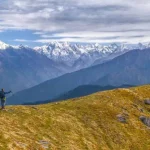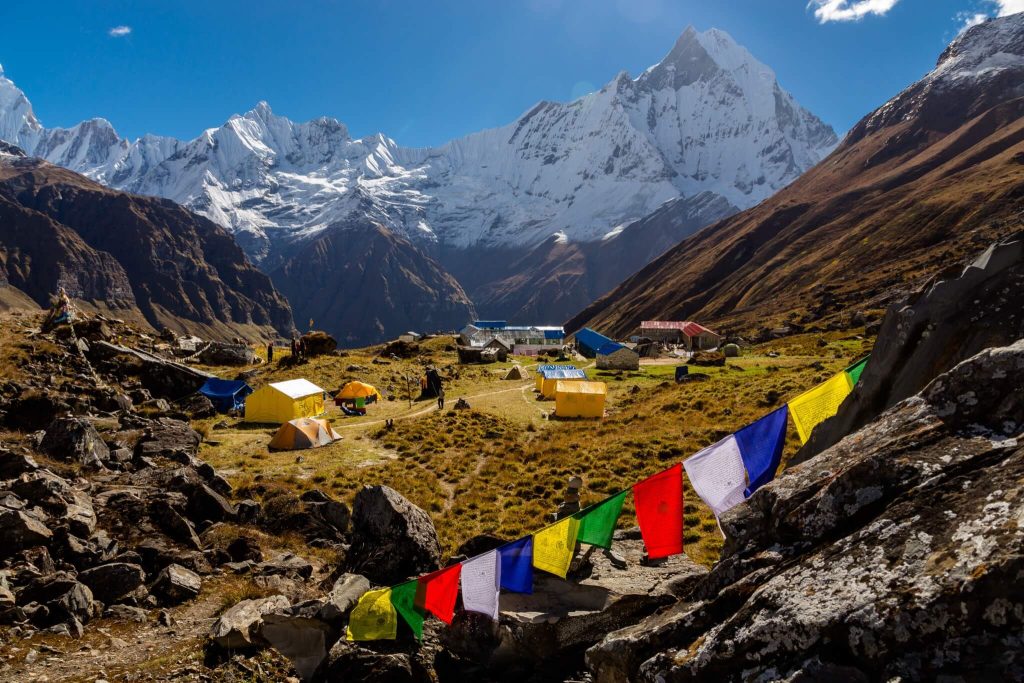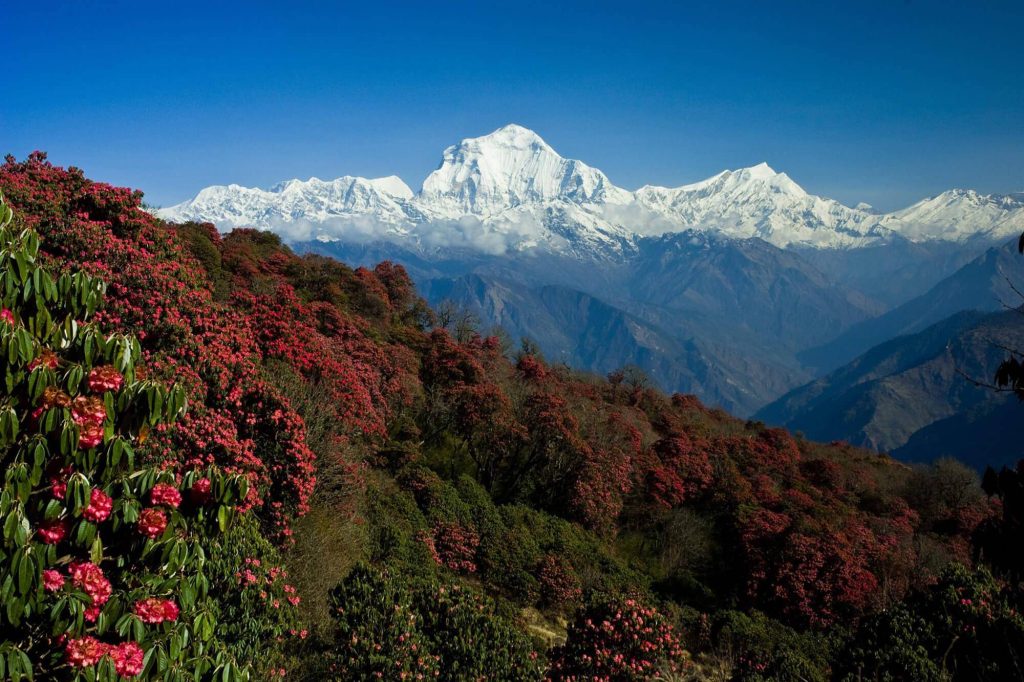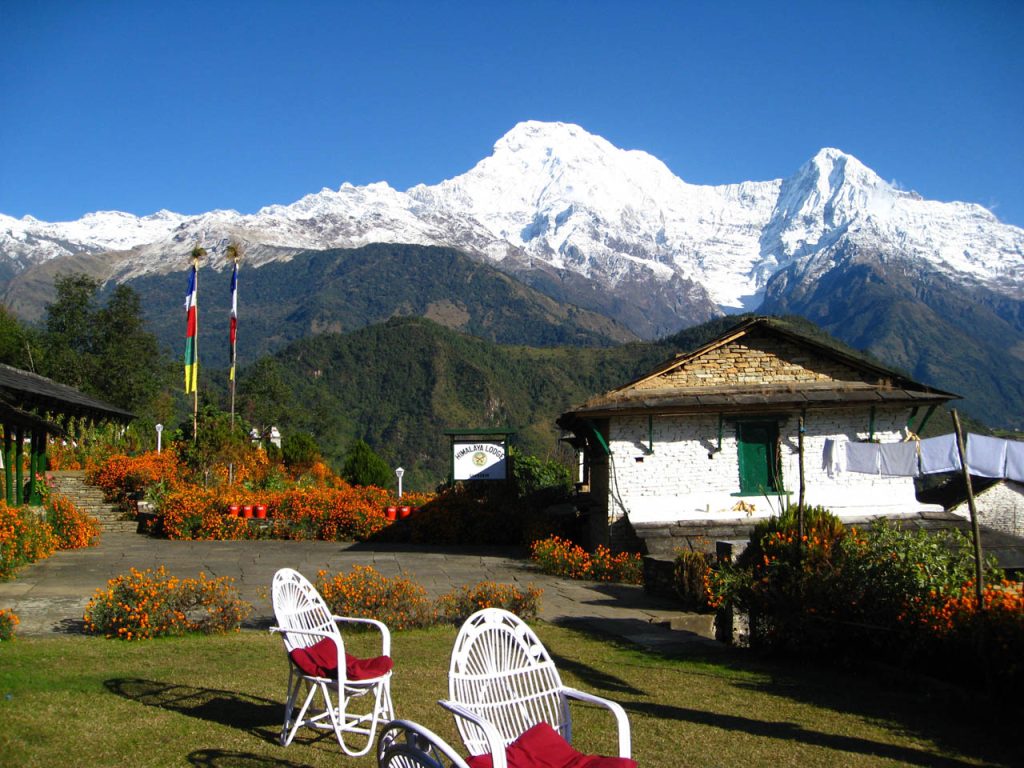Trek booking opened for 2024/25 ! A notice for Lukla flight diversion through Manthali Airport from March, April and October and November 2024 !

Trek booking opened for 2024/25 ! A notice for Lukla flight diversion through Manthali Airport from March, April and October and November 2024 !
The Annapurna Base Camp Trek in November offers one of the best weather conditions with remarkable views of the mountains. It is the perfect time to trek into the laps of Mount Annapurna and explore its scenic beauty.
Annapurna Base Camp Trek is one of Nepal’s most popular trekking destinations. Its moderately challenging trails within the Annapurna Conservation Area are full of pristine nature and age-old heritage. En route, you will traverse the charming Gurung and Magar villages, cascading rivers, streaming waterfalls, and a rejuvenating hot spring.
The mountain views will keep you company as you trek through the luscious subtropical forests to highland pastures. The captivating views of Mount Annapurna I, Annapurna II, Annapurna III, Annapurna South, Machhapuchhre (Fishtail), Dhaulagiri, and more appeal to trekkers, mountaineers, and naturalists worldwide.
November falls in autumn, the peak season and best time for trekking in Nepal. November usually offers clear and pleasant weather with moderate temperatures. These contribute to making the trek experience comfortable. Similarly, the flora and fauna are the most active at this time of the year. This allows you to savor the ABC trails’ beauty, active flora, and fauna. Hence, it is the best month for ABC Trek.
Read to the end to learn what magical experience awaits you during the Annapurna Base Camp Trek in November. Let’s dive into more details!

There are plenty of reasons to choose Annapurna Base Camp Trek in November. However, if we have to highlight the major ones, it includes the following:
The weather and climatic conditions greatly influence the trek experience. November is among the peak seasons for trekking in Nepal for a reason. The weather in November is stable and favorable. Meanwhile, the precipitation level is very low, so there is a lesser chance of rainfall during this time. The trekking routes in Nepal, including Annapurna, are dry and in good condition.
The dry season also means no obstruction to the stunning views. You can enjoy the gorgeous views of the mountains and vibrant landscapes. The temperature in November at lower and higher elevations is usually warm. Despite the stable weather, the temperature drops during the night. Take a look at the temperature of Annapurna Base Camp Trek in November-
| Location | Elevation | Min Temp | Max Temp | Avg Temp |
| Pokhara | 1400 meter | 20.2°C | 28°C | 18.3°C |
| Chhomrong | 2150 meter | 8°C | 24°C | 12°C |
| Dovan | 2500 meter | 6.6°C | 20.5°C | 20°C |
| Deurali | 3200 meter | 18°C | 18.5°C | 18°C |
| Annapurna Base Camp | 4130 meter | 0°C | 20°C | 4°C |
| Jhinu Danda | 1600 meter | 14°C | 24°C | 8°C |
Annapurna region is rich in diverse flora and fauna. The Annapurna Sanctuary lies en route to the base camp. Autumn and spring are two trekking seasons when these flora and fauna are the most active. Hence, during the Trek to ABC in November, you can witness the vibrant and thriving landscapes of the region. Similarly, you can get a chance to encounter rare wildlife during the trek.

In addition to the luscious green forests and Himalayan flora in bloom, you can enjoy stunning mountain views of the Annapurna ranges, Machhapuchre, Dhaulagiri, Himchuli, etc. The clear blue sky offers a beautiful backdrop for the snow-capped peaks. Therefore, trekking in the Annapurna region is the best way to explore and witness diversity.
The Annapurna Base Camp Trek is an adventure and a journey into Nepal’s rich culture and traditions. Along the trek trails, the locals run traditional and cozy tea houses so that you can get an authentic taste of the local delicacies and customs. There are also dress rental shops where you can try on the traditional attires and jewelry of the Gurung and Magar people.
Another great thing about ABC Trek in November is that you get to participate in the festive celebrations. Tihar, one of the biggest Nepali festivals, falls now so that you can witness traditional dances, music, and feasting. The biggest Nepali festivals, Dashain and Tihar, fall in October and November.
The permits and documents necessary for the Annapurna Base Camp Trek are as follows:
Every foreigner must take a Nepal visa to travel and participate in various activities, including trekking. You can easily obtain the visa-on-arrival at Tribhuvan International Airport, Kathmandu. However, you must have at least six months of dates remaining on your passport before expiry.
The cost of a visa will vary depending on the duration of your stay. The visa costs are as follows:
| Duration | Cost of Visa |
| 15 Days | USD 30 |
| 30 Days | USD 50 |
| 90 Days | USD 125 |
You can extend your visa from the Department of Immigration, Kathmandu, or the Immigration Office, Pokhara. However, you must apply before your previous visa expires. You will have to pay USD 45 for 15-day visa extensions. If you want to add more, you must pay an additional USD 3 per day.
All trekkers must have travel insurance for the Annapurna Base Camp Trek. Since it is a high-altitude trek, the insurance must cover high-altitude rescue and evacuation (above 3000 meters), including helicopter rescue and medical and emergency expenses.
Since ABC is a high-altitude trek, altitude sickness is likely. There are also chances of injuries and accidents that may require helicopter rescue or immediate medical assistance. Travel insurance provides a huge relief at such times.
You will need two Annapurna Base Camp Trek permits: a TIMS (Trekkers Information Management System) card and an ACAP (Annapurna Conservation Area Entry Permit). You can obtain both permits from Kathmandu or Pokhara through a registered travel agency. Since it is one of Nepal’s most popular trekking routes, getting permits in November can be difficult, so you should consult your trekking agency accordingly.
The TIMS card records the trekker’s personal information, trek details, itinerary, and emergency contact number. It helps ensure trekkers’ safety and security during natural disasters and emergencies. The cost of the card varies for SAARC residents and non-SAARC residents. The color and cost of the card are also different for solo and group trekkers.
The costs of a TIMS card are as follows:
| Costs | Card Color | |
| Solo SAARC resident | NPR 600 | Green |
| Group SAARC residents | NPR 300 | Blue |
| Solo Non-SAARC resident | NPR 1000 | Green |
| Group Non-SAARC residents | NPR 2000 | Blue |
The Annapurna Base Camp trails lie within the Annapurna Conservation Area, the largest conservation area in the country. The project protects and preserves the region’s flora, fauna, and cultural heritage. Hence, you will need an entry permit to access the area.
The cost of ACAP permits are as follows:
| Costs | |
| SAARC resident | NPR 1000 |
| Non-SAARC residents | NPR 3000 |
The temperature is generally warm during November. However, it can get cold at night, so trekkers should pack accordingly. Take a look at some clothing and equipment packing lists for Annapurna Base Camp in November:
To access the Annapurna Base Camp trails, you must first travel from Kathmandu to Pokhara. Both cities are well connected by road and air so that you can take either. A roadway is a budget-friendly option compared to flights. However, driving through the scenic Prithvi Highway takes 7 to 8 hours, while a flight from Kathmandu to Pokhara takes around 30 minutes. The weather and temperature are stable, so a flight delay or cancellation is less likely.
Since November is the peak tourist season, many travelers visit Nepal. Therefore, either transportation can get congested at this time. Likewise, the cost of buses and flights increases due to high demand. If you are considering traveling in November, book your tickets in advance.
Along the trails of the Annapurna region, you will mostly find teahouses, lodges, guesthouses, and homestays for accommodations. Although there are many accommodations, they will most likely be fully booked as November is the peak season for trekkers. As a result, you may have to share rooms with fellow trekkers.

It will be easier to find one if you pre-book them in advance. Camping is an option, but it is not popular among trekkers. If you cannot find rooms, you may have to sleep in a dining or communal space in a sleeping bag. Therefore, we highly advise asking your trekking agency to book one.
Take a look at the day-to-day itinerary for Annapurna Base Camp Trek:
For safe and comfortable trekking, here are a few tips for Annapurna Base Camp in November:
Related Article: Annapurna Base Camp Trek in October
The Annapurna Base Camp is a moderate trek that takes 7 to 12 days to complete. It is ideal for beginners and has no age restriction. However, the trek is physically demanding. You will have to trek on uneven and rugged terrain while climbing steep uphill and downhill.
Similarly, you will climb up and down more than 3000 stone staircases. The average daily walking time is 5 to 6 hours, so trekkers must be physically fit. The winding trails to Annapurna Base Camp will test your physical strength, stamina, and endurance. So, trekkers have to prepare properly for the trek.
Despite the season, the weather is unpredictable at higher elevations. It changes rapidly, which can make the trek challenging. There can be rain showers or high wind, which can affect your trek. The Annapurna Base Camp temperature is significantly different between lower and higher elevations.
The temperature at higher elevations can often drop at night. The average temperature ranges from 15 to 20°C in the daytime and drops below 0°C at night. Therefore, you must prepare proper clothing and gear in November to tackle the unpredictable weather while trekking in Annapurna Base Camp.
The Annapurna Base Camp Trek elevation is relatively lower than that of the Annapurna Circuit Trek and Everest Base Camp Trek. However, you will still trek above 3000 meters and reach an elevation of 4130 meters. After 3000 meters, the oxygen level and air pressure begin to reduce, resulting in a risk of altitude sickness.
The common symptoms of altitude sickness include headache, fatigue, insomnia, nausea, dizziness, and shortness of breath. It can range from mild to severe and prove fatal. Hence, proper precaution and acclimatization are crucial during ABC Trek to minimize the risk of altitude sickness.
Some safety measures and emergency protocols for the ABC Trek:
If you want to enjoy the peak beauty of the Annapurna region, the Annapurna Base Camp Trek in November is the perfect time for you. The trails are brimming with natural beauty, from a crystal-clear view of the gleaming mountains to diverse flora, fauna, and clear rivers. The warm smiles and hospitality of the locals are always ready to welcome you.
We hope you will find our little list helpful. If you want to hike or trek in Nepal, Nepal Alternative Treks is here to help. For booking or any inquiries, you can contact us.
Need assistance? Our travel expert Tej Bahadur Gurung is here to help! Please fill out the form below to initiate a chat and get your queries resolved quickly.